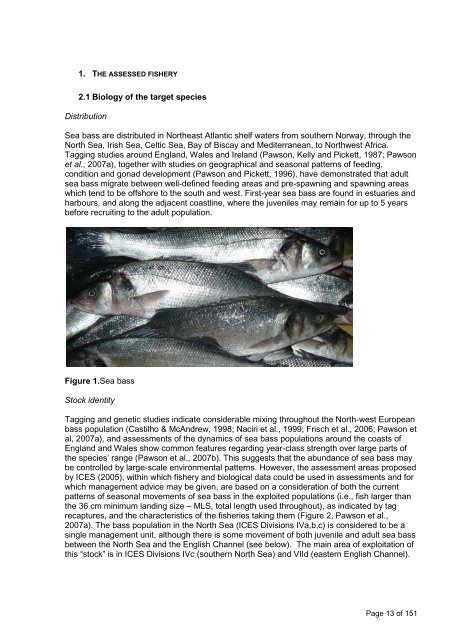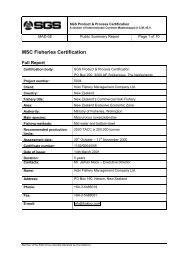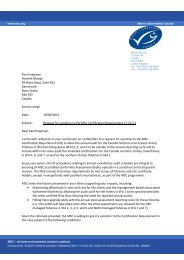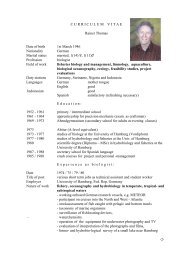SGS Product & Process Certification - Marine Stewardship Council
SGS Product & Process Certification - Marine Stewardship Council
SGS Product & Process Certification - Marine Stewardship Council
You also want an ePaper? Increase the reach of your titles
YUMPU automatically turns print PDFs into web optimized ePapers that Google loves.
1. THE ASSESSED FISHERY<br />
2.1 Biology of the target species<br />
Distribution<br />
Sea bass are distributed in Northeast Atlantic shelf waters from southern Norway, through the<br />
North Sea, Irish Sea, Celtic Sea, Bay of Biscay and Mediterranean, to Northwest Africa.<br />
Tagging studies around England, Wales and Ireland (Pawson, Kelly and Pickett, 1987; Pawson<br />
et al., 2007a), together with studies on geographical and seasonal patterns of feeding,<br />
condition and gonad development (Pawson and Pickett, 1996), have demonstrated that adult<br />
sea bass migrate between well-defined feeding areas and pre-spawning and spawning areas<br />
which tend to be offshore to the south and west. First-year sea bass are found in estuaries and<br />
harbours, and along the adjacent coastline, where the juveniles may remain for up to 5 years<br />
before recruiting to the adult population.<br />
Figure 1.Sea bass<br />
Stock identity<br />
Tagging and genetic studies indicate considerable mixing throughout the North-west European<br />
bass population (Castilho & McAndrew, 1998; Naciri et al., 1999; Frisch et al., 2006; Pawson et<br />
al, 2007a), and assessments of the dynamics of sea bass populations around the coasts of<br />
England and Wales show common features regarding year-class strength over large parts of<br />
the species‘ range (Pawson et al., 2007b). This suggests that the abundance of sea bass may<br />
be controlled by large-scale environmental patterns. However, the assessment areas proposed<br />
by ICES (2005), within which fishery and biological data could be used in assessments and for<br />
which management advice may be given, are based on a consideration of both the current<br />
patterns of seasonal movements of sea bass in the exploited populations (i.e., fish larger than<br />
the 36 cm minimum landing size – MLS, total length used throughout), as indicated by tag<br />
recaptures, and the characteristics of the fisheries taking them (Figure 2, Pawson et al.,<br />
2007a). The bass population in the North Sea (ICES Divisions IVa,b,c) is considered to be a<br />
single management unit, although there is some movement of both juvenile and adult sea bass<br />
between the North Sea and the English Channel (see below). The main area of exploitation of<br />
this ―stock‖ is in ICES Divisions IVc (southern North Sea) and VIId (eastern English Channel).<br />
Page 13 of 151





